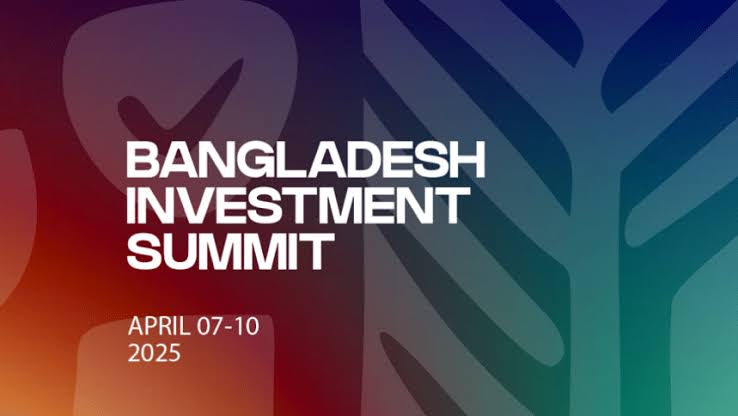Special Correspondent
Published:2025-04-11 19:29:53 BdST
Investment summit over, now the work begins – BIDA on next steps
Billions of dollars in investment pledges, a new pipeline for foreign investors, and growing confidence in Bangladesh’s potential – these were the major outcomes – as the curtain fell on the four-day Bangladesh Investment Summit on Thursday.
From bustling networking sessions to forward-looking policy discussions, the summit, held from 7–10 April 2025 in Dhaka, drew more than 550 participants, including over 400 foreign delegates.
It ended on a high note with organisers celebrating what they described as a strong show of intent from international investors – especially in key sectors such as apparel, healthcare, consumer goods, pharmaceuticals, light engineering, and renewable energy.
At the closing press briefing, Nahian Rahman Rochi, Head of Business Development at the Bangladesh Investment Development Authority (BIDA), announced the creation of a dedicated foreign investment pipeline and assured that every investor will be engaged on an individual basis to ensure their commitments translate into real outcomes.
“Investors typically take 18 to 24 months to implement their plans. We’ll be following up institution by institution to ensure nothing falls through the cracks,” he said.
Early wins and agreements
Among the confirmed outcomes, a $150 million agreement was signed with Chinese ready-made garment (RMG) giant Handa, while Bangladeshi digital commerce platform ShopUp secured $110 million in investment.
Though full figures are still being compiled, BIDA confirmed that several other large-scale proposals had been tabled and a comprehensive breakdown will be provided in an upcoming press briefing.
The enthusiasm, however, was met with equal doses of realism. Investors voiced concerns about hurdles such as bureaucratic inefficiency, policy inconsistency, and corruption – issues that BIDA officials acknowledged candidly. “We’re not in denial,” Rochi said.
“Our services – not just at NBR [National Board of Revenue] but across several departments – are slow, and we are actively working on inter-ministerial coordination to fix this.”
He also mentioned the creation of a “green channel” within the NBR to expedite investment-related clearances and reduce red tape. “We're listening, and we’re acting,” he added.
Textile industry eyes global no. 1 spot
One of the most stirring visions for Bangladesh’s economic future came from Kiak Sung, founder of the Korean Export Processing Zone (EPZ), who believes Bangladesh is poised to become the world’s number one apparel exporter – if it plays its cards right.
“To get there, Bangladesh needs to embrace advanced manufacturing technologies, train its workforce more effectively, and start producing man-made fibres locally,” Sung said during his keynote speech.
He also urged policymakers to expand bonded warehousing, which would allow faster access to imported raw materials and shorten production cycles.
Commenting on international trade shifts, he praised Bangladesh’s proactive diplomacy in response to the temporary suspension of Trump-era tariffs.
“That’s bought some breathing room,” he noted. “But if we want long-term competitiveness, we must focus on value-added products. Simply exporting low-margin garments won’t be enough in the next decade.”
Healthcare a $23b opportunity by 2033
Another major highlight was the call to action for investment in Bangladesh’s rapidly growing healthcare sector. Experts at a session titled "Unlocking Healthcare Investment Potential in Bangladesh" painted a picture of a sector on the cusp of transformation, predicting a market size of $23 billion by 2033.
“This sector is no longer an afterthought – it’s one of the main drivers of economic growth,” said Md Saidur Rahman, Secretary of the Health Services Division.
He pointed to a growing population, a rising middle class, and the increasing prevalence of chronic diseases as key demand drivers.
Sylvana Quader Sinha, founder and CEO of Praava Health, delivered a compelling keynote outlining not just where the opportunities lie, but how they can be tapped.
“Right now, our medical equipment market is projected to reach $3 billion by 2030, and much of that is still import-dependent. That’s a huge opportunity for local manufacturing,” she said.
Sinha highlighted areas ripe for investment – including diagnostic kits, low-risk monitoring devices, OT support tools, and ICU equipment. She also pointed out that Bangladesh’s healthcare sector has grown at a compound annual rate of 10.3% since 2010 and now employs nearly 300,000 people directly.
“The future is not just about hospitals and drugs,” she said. “It’s about digital transformation.”
Post-pandemic, telehealth, cloud-based electronic health records, and AI-driven diagnostics have become central to Bangladesh’s Digital Healthcare Strategy 2023–2027.
Sinha called on investors to look closely at digital healthcare platforms, cloud services, and remote patient monitoring solutions – all areas with strong government backing and rising consumer demand.
Pharmaceutical growth, PPPs, and a shift to self-reliance
The pharmaceutical industry – already recognised as one of the country’s strongest sectors – is projected to reach $6 billion in market size by 2025, growing at 12% annually.
With a strong foundation in branded generics, Bangladesh is already meeting nearly all of its domestic pharmaceutical needs, said Sinha.
Public-private partnerships (PPPs) and tax incentives for setting up healthcare facilities outside major cities are further improving the investment climate.
“There is growing demand for tertiary and specialised care in cities, but also for accessible primary care in rural areas. That’s where PPPs can really make a difference,” she added.
Unauthorized use or reproduction of The Finance Today content for commercial purposes is strictly prohibited.


